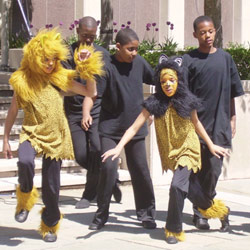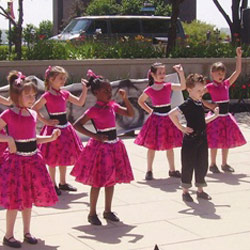In 2010, the Arts in Education Spring Celebration celebrates 25 years at the Peoria County Courthouse Plaza.
Sue Kingery, who directs the Arts in Education Spring Celebration, enthusiastically calls the Peoria area’s annual showcase of young artists and musicians a “highlight and harbinger of spring.” Her spirited declaration is apt. Its outdoor performances cheerily welcome the warmer months, but the metaphor goes deeper. The celebration’s story, one of growth, renewal and unity—as demonstrated by the cooperation of local schools, government and businesses—reflects the sentiments associated with the season it helps ring in.
The Arts in Education Spring Celebration began humbly, as a response to the significant weakening of the fine arts curricula in Peoria in the mid-1980s. The inaugural event welcomed 1,000 students from 12 schools for a week of performances. Over the last 25 years, it has blossomed into a six-week series of performances that brings together more than 17,000 students—Pre-K through 12th grade—from over 130 schools and six counties to the scenic Peoria County Courthouse Plaza. In 2009, more than 250 music, dance and speech performances, as well as 200 art exhibits, took place. Through community support and the diligence of its organizers and participants, the Spring Celebration has flourished. Perhaps most inspiring, though, is the profound influence such outlets for creativity can have on students.
 Lessons for the Classroom and Beyond
Lessons for the Classroom and Beyond
The Arts in Education Spring Celebration, running from mid-April to the end of May, provides an opportunity for students to share their talents with the community. Performing on weekdays from 11am to 1:30pm, the students receive public recognition and community-wide praise for their abilities in a noncompetitive environment. The students bring joy to the city each spring, but the event benefits the participants as well as the spectators.
Kingery notes that, while students’ participation in sports often earns them notoriety, and the misdeeds of young people capture public attention, art and music programs can be undervalued, while the acknowledgement of artistically inclined students can be a rarity outside the classroom. Peoria County Regional Superintendent of Education Dr. Gerald Brookhart describes the celebration as an opportunity to “highlight the good things good kids do everyday.” The annual performances aim to place the fine arts in the public eye and ignite students’ passions for creativity.
The Arts in Education Spring Celebration extols the immediate, practical virtues of fine arts programs. Education in the arts motivates students and seems to improve social behavior and class attendance. Such programs even bolster student achievement in mathematics, reading, language and fundamental cognitive skills. Progress is not confined to the school setting, however.
Kingery explains that simply coming to downtown Peoria can provide students from rural areas with an “eye-opening life experience” because the city setting is unfamiliar to them.
Another moving encounter was experienced by children from a District 150 school at Northwoods Mall, where the festival is moved when weather disrupts performances. Their teacher exclaimed to Kingery that simply visiting the mall was a delight for the students—some had never even seen escalators.
The real thrill for these children came after performing a song, both orally and through sign language. After they left the stage, a deaf person approached the teacher to praise the students and ask for a private encore performance. Kingery, who is on-site everyday of the Spring Celebration, remarks that such experiences “confirm how important this program is.”
 Harmony On and Off the Stage
Harmony On and Off the Stage
While the Spring Celebration’s continued growth is a source of optimism, it has also necessitated synergy between the city, county, local businesses and schools, who have cooperated with remarkable efficiency and success.
Developed by the Peoria County Regional Office of Education (PCROE), the project has become such a large undertaking that work must begin nearly 10 months in advance. Fundraising begins in August and continues to the spring, schools are contacted in October, and by February of the next year, schedules are set. Equipment needed by schools—microphones, speakers and sound technology, risers and chairs—are provided by the PCROE, and temporary employees are hired to set up stages. While the program is partially sponsored by a grant from the Illinois Arts Council, a state agency, and the Community Foundation of Central Illinois, Caterpillar Inc. and the Ruby K. Warner Fund serve as primary sponsors. Other major contributions come from AmerenCILCO, Illinois American Water, local banks and others.
Due to the extended scope of the Spring Celebration, Kingery and other event organizers require the assistance of the city and county, who welcome the program to the bustling Peoria County Courthouse Plaza each year. According to Kingery, the plaza was chosen because it provides a “wonderful, park-like setting,” and she praises the county and its maintenance workers for assuring that it always looks beautiful.
A relaxed stroll among the brilliant reds and yellows of the airy plaza’s tulips confirms why the site is so appropriate for a spring welcoming. The planners incorporate the design of the court into the performances, cleverly utilizing its aesthetic focal points. The main stages are by the large monument and the plaza’s circle which contains the fountain; an additional, smaller stage resides at the intersection of Main and Jefferson.
Besides contributing to the merry spring atmosphere, the Spring Celebration also affords Peoria a sense of cultural prestige. Kingery remarks that visitors from out of town often applaud the festival, especially because even larger cities like Chicago tend to lack comparable programs. In fact, the PCROE is proud to say that this program is the only one of its kind in the United States.
Each year, a variety of organizations come together to provide the support necessary so students can shine in the public realm and spectators can catch a glimpse of the bright talents arising in the fine arts. While the work that must go into an event of this magnitude seems arduous, Sue Kingery maintains that she is privileged to direct the program, calling her position the “best job in the world.” a&s
For more information about the Arts In Education Spring Celebration, visit springcelebration.org.


